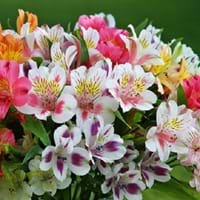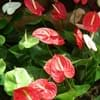Life Span
Annual
Perennial
Type
Tender Perennial
Flowering Plants, Fruits, Trees
Origin
South America, Argentina, Chile
Central Asia
Types
Not Available
Aceymac apple, Bailey Sweet apple, Dabinett apple, Nehou apple
Number of Varieties
Not Available
Habitat
Cultivated Beds
Hillside
USDA Hardiness Zone
8-11
5-8
Sunset Zone
H1, 5, 6, 7, 8, 9, 14, 15, 16, 17, 18, 19, 20, 21, 22, 23, 24
A1, A2, A3, 8, 9, 10, 11, 12, 13, 14, 15, 16, 17, 18, 19, 20, 21, 22, 23, 24
Habit
Clump-Forming
Oval or Rounded
Flower Color
Light Pink, Lavender, Orange Red
White
Flower Color Modifier
Multi-Color
Not Available
Fruit Color
Yellow green
Green, Red
Leaf Color in Spring
Light Green, Gray Green
Dark Green
Leaf Color in Summer
Light Green, Gray Green
Green
Leaf Color in Fall
Light Green, Gray Green
Brown, Green, Light Yellow
Leaf Color in Winter
Gray Green, Yellow green
Not Available
Leaf Shape
Lanceolate
Oblong
Plant Season
Summer
Spring
Sunlight
Full Sun, Partial Sun
Full Sun, Partial shade
Growth Rate
Medium
Medium
Type of Soil
Loam, Sand
Loamy
The pH of Soil
Acidic, Neutral
Neutral
Soil Drainage
Well drained
Well drained
Bloom Time
Early Summer, Summer, Late Summer
Fall, Summer
Tolerances
Drought
Drought
Where to Plant?
Ground
Ground
How to Plant?
Seedlings
Grafting, Seedlings, Transplanting
Plant Maintenance
Medium
Medium
Watering Requirements
Requires regular watering
Medium
In Summer
Lots of watering
Lots of watering
In Spring
Moderate
Moderate
In Winter
Average Water
Average Water
Soil pH
Acidic, Neutral
Neutral
Soil Type
Loam, Sand
Loamy
Soil Drainage Capacity
Well drained
Well drained
Sun Exposure
Full Sun, Partial Sun
Full Sun, Partial shade
Pruning
Remove damaged leaves, Remove dead branches, Remove dead leaves
Prune when plant is dormant, Remove dead or diseased plant parts
Fertilizers
All-Purpose Liquid Fertilizer
All-Purpose Liquid Fertilizer
Pests and Diseases
Red blotch
Aphids, Canker, Caterpillars, Powdery mildew, Root rot
Plant Tolerance
Drought
Drought
Flower Petal Number
Single
Single
Fragrant Bark/Stem
Not Available
No
Foliage Texture
Fine
Medium
Foliage Sheen
Matte
Matte
Attracts
Hummingbirds
Birds
Allergy
angioedema, Rhinoconjunctivitis, Throat itching, Urticaria
Mouth itching, Throat itching
Aesthetic Uses
Showy Purposes
Not Used For Aesthetic Purpose
Beauty Benefits
Not Available
Not Available
Environmental Uses
Air purification
Air purification
Medicinal Uses
Not Available
Cancer, constipation, Diabetes, Diarrhea, Dysentry, Fever, Heart problems, Tooth ache
Part of Plant Used
Flowers, Root
Fruits
Other Uses
Decoration Purposes
Used As Food, Wood is used for making furniture
Used As Indoor Plant
No
No
Used As Outdoor Plant
Yes
Yes
Garden Design
Cutflower, Mixed Border
Fruit / Fruit Tree, Shade Trees, Showy Tree
Botanical Name
ALSTROEMERIA ligtu
Malus domestica
Common Name
Lily-of-the-Incas, Peruvian-lily
Apple Tree
In Hindi
peruvian lily
सेब का वृक्ष
In German
peruanische Lilie
Apfelbaum
In French
lis des Incas
Pommier
In Spanish
lirio peruano
Manzano
In Greek
περουβιανή κρίνος
μηλιά
In Portuguese
lírio peruano
Macieira
In Polish
peruwiański lilia
jabłoń
In Latin
Peruviani lilium
Arbore
Phylum
Magnoliophyta
Magnoliophyta
Class
Liliopsida
Magnoliopsida
Family
Liliaceae
Rosaceae
Clade
Angiosperms, Monocots
Angiosperms, Eudicots, Rosids
Tribe
Not Available
Not Available
Subfamily
Not Available
Not Available
Number of Species
Not Available
Properties of Peruvian-Lily and Apple Tree
Wondering what are the properties of Peruvian-Lily and Apple Tree? We provide you with everything About Peruvian-Lily and Apple Tree. Peruvian-Lily doesn't have thorns and Apple Tree doesn't have thorns. Also Peruvian-Lily does not have fragrant flowers. Peruvian-Lily has allergic reactions like angioedema, Rhinoconjunctivitis, Throat itching and Urticaria and Apple Tree has allergic reactions like angioedema, Rhinoconjunctivitis, Throat itching and Urticaria. Compare all the properties and characteristics of these two plants. Find out which of these plant can be used as indoor plant. If you are interested to decorate your house and garden, find out aesthetic uses, compare them and select the plant which will beautify your surrounding. Along with beautification, try comparing medicinal and edible uses of Peruvian-Lily and Apple Tree and you can choose the plant having best and most benefits.
Season and Care of Peruvian-Lily and Apple Tree
Season and care of Peruvian-Lily and Apple Tree is important to know. While considering everything about Peruvian-Lily and Apple Tree Care, growing season is an essential factor. Peruvian-Lily season is Summer and Apple Tree season is Summer. The type of soil for Peruvian-Lily is Loam, Sand and for Apple Tree is Loamy while the PH of soil for Peruvian-Lily is Acidic, Neutral and for Apple Tree is Neutral.
Peruvian-Lily and Apple Tree Physical Information
Peruvian-Lily and Apple Tree physical information is very important for comparison. Peruvian-Lily height is 38.10 cm and width 61.00 cm whereas Apple Tree height is 25.00 cm and width 20.00 cm. The color specification of Peruvian-Lily and Apple Tree are as follows:
Peruvian-Lily flower color: Light Pink, Lavender and Orange Red
Peruvian-Lily leaf color: Light Green and Gray Green
Apple Tree flower color: White
- Apple Tree leaf color: Dark Green
Care of Peruvian-Lily and Apple Tree
Care of Peruvian-Lily and Apple Tree include pruning, fertilizers, watering etc. Peruvian-Lily pruning is done Remove damaged leaves, Remove dead branches and Remove dead leaves and Apple Tree pruning is done Prune when plant is dormant and Remove dead or diseased plant parts. In summer Peruvian-Lily needs Lots of watering and in winter, it needs Average Water. Whereas, in summer Apple Tree needs Lots of watering and in winter, it needs Average Water.





